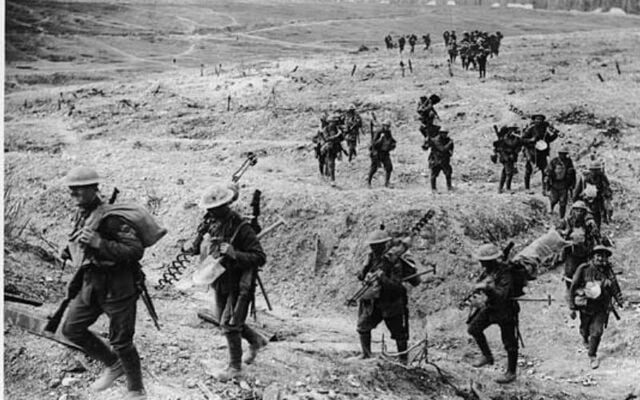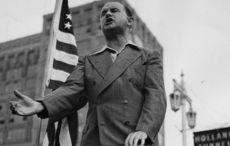The tragic loss of life, unfilled potential and neglect, and rejection of those survivors who gave so greatly 107 years ago in the “war to end all wars”.
On 24 August 1914, the 2nd Battalion of the Royal Dublin Fusiliers arrived at the train station in the northern French town of Le Cateau. Late that evening they fired their first shots in the First World War against advancing German cavalry scouts. The previous day, they had disembarked from the troop ship SS Caledonia at the port of Boulogne to which they had sailed from Southampton.
A little over four years later, on 17 October 1918, the same 2nd Royal Dublin Fusiliers were back fighting the Germans near the train station at Le Cateau.
In between those dates, the lines along the Western Front moved backward and forwards like the bellows of a melodeon with net gains on either side of the wire amounting to little or nothing. The loss of life achieving those fruitless movements resulted in the deaths of some 9.7 million military personnel. Civilian deaths amounted to a similar neat number.
If ever there was a symbol that represents the futilely of war and the tragedy of the First World War, in particular, it is that quiet and now rarely used train station in Le Cateau.
The First World War was a civilian’s war.
Read more
The Irish men who enlisted into Kitchener’s Irish infantry Divisions and women who served as volunteers in the Red Cross and John’s Ambulance Brigades came from a cross-section of Irish society. Men enlisted for a variety of reasons, as numerous as the men who enlisted. Some joined up out of economic necessity. It is no coincidence that the highest number of Dublin Fusiliers who died in the war came from the tenement buildings and lane way cottages of Dublin’s inner city; essentially from between the canals. Others enlisted for adventure, and others are driven by political ideology.
The recruitment tactics used to entice men from sports clubs, societies and workplaces into Pals battalions such as the 7th and 10th Royal Dublin Fusiliers worked well for the recruiting sergeants. ‘Come along with your Pal’, was the recruiting call.
However, when the killing and maiming started in battles with familiar names such as The Marne in 1914, Gallipoli in 1915, The Somme in 1916, Passchendaele in 1917 and the German and Allied offensives of 1918; the tragic consequences of the Pals recruiting tactics resulted in the destruction of the sports clubs, work groups, and friends; the building blocks of the societies from whence they came.
Almost every town and village on the island of Ireland had its share of casualties. Indeed, war and revolution combined to hit some Irish families with particular vengeance.
Mrs. Mc Donald from Bride Street in Dublin lost her three sons during April and May 1915 as a result of a German gas attack on the Dublin Fusiliers north of Ypres.
Mrs. Malone lost one son Willie in the same gas attack. A year later, another of her sons Michael was killed fighting with the Irish Volunteers during the 1916 Easter Rising on Northumberland Road in Dublin.
Mrs. Kent from Cork lost her son Eamon as a result of the same Easter Rising. In April 1917 she lost her other son Bill, a sergeant in the 1st Royal Dublin Fusiliers during the Battle of Arras.
Had I been the father of any of these young men who died, I know what I would have said to those who claimed him to suit their own ideology. I would have said; ‘To hell with your wars and revolutions, they have cost me, my family.’
A further human tragedy of the First World War and indeed all wars through the loss of life or injury was the loss of unfulfilled human potential. What could the thousands of wasted lives have contributed to the world around them had they lived?
Read more
John Boland was a 19-year-old messenger boy from Russel Street in Dublin. He enlisted in 1913, the year of the General Lockout and was killed in August 1914 with the 2nd Dublin’s at the Battle of Le Cateau. Michael Wall was also a 19-year-old lad from Carrick Hill, in Portmarnock, north county Dublin. He enlisted for adventure perhaps tinged with a hint of patriotic duty to King and country. He was on his way to UCD to study science or engineering but decided to enlist instead.
He was killed with his commanding officer, the Irish Parliamentary Party MP, Major Willie Redmond at the Battle of Messines on 7 June 1917.
Tom Kettle, a barrister, and professor of national economics at UCD was killed leading his Dublin Fusiliers at Ginchy during the Somme campaign on 9 September 1916. He died for, ‘a dream born in a herdsman’s shed.’
Whether they were messenger boys, student engineers or barristers, these three Irish men never fulfilled their potential. What they could have achieved and contributed to Ireland and the world had there not been a war; sadly, we will never know. And we Irish did not have the monopoly on the loss of such potential.
Just think of all the German or Turkish poets, doctors, and indeed messenger boys who never fulfilled their dreams or potential either.
The Irish men who came back to Ireland at the end of their war in 1918, one estimate is 150,000, and indeed the nursing women came home to an Ireland that had politically changed.
Their place in Irish history traveled a journey from initially keeping their heads down during the War of Independence years, to years of holding their heads up at annual remembrance parades, to fading away, to being reborn. I would argue their fall from Irish memory in the 60s, 70s, and the 80s, parallel with the demise of the National War Memorial at Islandbridge, was partly due to the natural process of aging along with the often-fractious relationship between Ireland and the United Kingdom, particularly during the years of the so-called Troubles resulting in neglect in Irish historiography.
I have often compared the death and rebirth in memory of the Irish men and women who took part in that dreadful conflict, to the letters, postcards and old trinkets that we put in shoe boxes and biscuit tins dumped in our attics, dead and forgotten; to be discovered by a new generation and placed in our window boxes in the front window, a place we show off the trinkets we are proud of.
Their death and rebirth in memory may also be analogous to the dereliction of Islandbridge in the 60s and 70s to its redevelopment and restoration as a national monument in the late 1980s. That rebirth is also expressed in the growth of interest in Ireland’s participation in the First World War through the creation of historical societies such as The Royal Dublin Fusiliers Association, public exhibitions and seminars, new books and Irish people visiting the battlefields of France, Flanders, Gallipoli, and Salonicka.
Read more
Enhancing that process of rebirth is successive Irish government’s participation in remembrance projects such as at Messines in 1998 at the opening of the Irish Pease Park and The Somme commemorations at Thiepval in July 2016, all of which have contributed to the Irish peace process. In fact. there is a line, thin and often damaged as it may be, that represents successive Irish governments’ respectful recognition of the Irish participation in the First World War.
A line that linked Kevin O’Higgins in 1927 when he stated he had.
“Respectful admiration…for the men who went out to France and fought there and died there, believing that by doing so they were serving the best interests of their country.”
To Michel D Higgins in July 2014 when he stated.
“We cannot give back their lives to the dead, nor whole bodies to those who were wounded, or repair the grief, undo the disrespect that was sometimes shown to those who fought or their families. But we honor them all now, even if at a distance…
“To all of them in their silence we offer our own silence, without judgment, and with respect for their ideals, as they knew them, and for the humanity, they expressed towards each other. And we offer our sorrow too that they and their families were not given the compassion and the understanding over the decades that they should have received. The suffering visited upon our own people at home had perhaps blinded our sight and hardened hearts in so many ways.”
Train stations and railway lines across the world have been associated with the horror of war; such as the train station at Auschwitz, or the railway line built by Allied POWs across Burma. The quiet train station at Le Cateau may not be as famous as Auschwitz or Burma, but lest we forget, it is a little-known reminder of the tragedy of the war that was supposed to end all wars 107 years ago.
* Tom Burke is the Chairman of The Royal Dublin Fusiliers Association. For more information visit www.greatwar.ie.
* This article was originally published in 2018, updated in 2025.




Comments